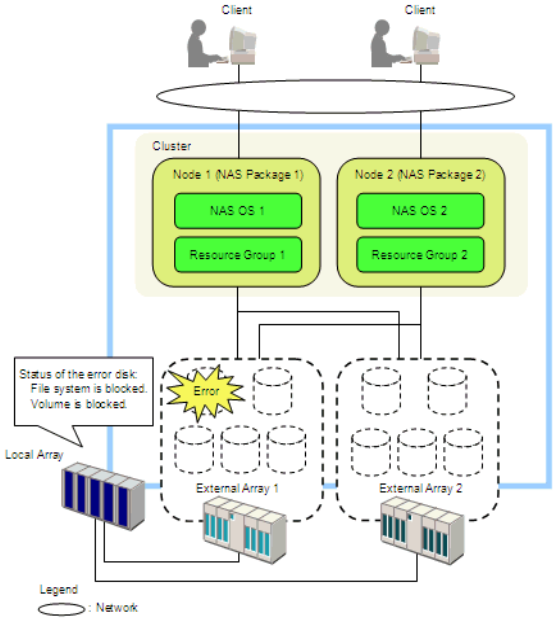HP StorageWorks External Storage XP user guide (T1706-96006, June 2006)
Table Of Contents
- HP StorageWorks External Storage XP user guide
- Contents
- About this guide
- 1 Overview of connecting external arrays
- 2 Preparing for External Storage XP operations
- System requirements
- External Storage XP requirements
- Installing External Storage XP
- Preparing for External Storage XP settings
- Powering arrays on or off
- Using mapped external LUs from the host connected to the local array
- Uninstalling External Storage XP
- Limitations on External Storage XP operations
- Figure 11 Example of external LU with 2 TB or less
- Figure 12 External LU capacity is larger than the specified emulation type’s basic capacity (OPEN-3 example)
- Figure 13 External LU capacity is smaller than the specified emulation type’s basic capacity
- Table 4 When external LU’s emulation type is OPEN
- Table 5 When external LU’s emulation type is for mainframes
- Combining External Storage XP with other HP StorageWorks products
- 3 Managing cache with external storage
- Guidelines for using cache with external storage
- Determining, setting, or changing the external LU cache mode
- Partitioning cache for external storage
- Determining the number and size of needed partitions
- Creating Cache partitions
- Changing storage system modes
- 4 External Storage XP panes
- 5 Configuring external LUs
- Overview of configuring external LUs
- Setting an external array’s port
- Setting a local array’s port attributes
- Mapping external LUs (Add LU)
- Setting alternate paths for external LUs
- Adding alternate paths by selecting multiple external LUs (Add Paths)
- Deleting alternate paths by selecting multiple external LUs (Delete Paths)
- Checking an external LU’s status (LDEV Information)
- Disconnecting external arrays or LUs
- Checking the connection status and resuming external LU operations (Check Paths & Restore Vol.)
- Restoring external LUs (LDEV Restore)
- Stopping the use of paths to an external LU by specifying an external array’s WWN (Disconnect Paths)
- Restoring paths to an external LU by specifying an external array’s WWN (Check Paths)
- Changing an external array’s port setting
- Stopping the use of paths to an external LU by specifying a local array’s port (Disconnect Paths)
- Restoring paths to an external LU by specifying a local array’s port (Check Paths)
- Deleting external LU mappings (Delete LU)
- 6 Troubleshooting NAS Blade systems that include external arrays
- 7 Remote command devices
- 8 Troubleshooting External Storage XP
- A Notes on connecting external arrays
- Connecting Thunder 9500V subsystems
- System parameters for connecting Thunder 9500V subsystems
- Relationship between serial numbers in the Device list on the LU Operation pane and Thunder 9500V subsystem models
- Relationship between the WWN of the port on the Thunder 9500V subsystem and the controller
- Path status and examples of recovery procedures (Thunder 9500V subsystems)
- Connecting TagmaStore AMS and TagmaStore WMS subsystems
- System parameters for connecting TagmaStore AMS and TagmaStore WMS subsystems
- Relationship between serial numbers in the Device list on the LU Operation pane and TagmaStore AMS and TagmaStore WMS subsystem models
- Relationship between the WWN of the port on the TagmaStore AMS or TagmaStore WMS subsystem and the controller
- Path status and examples of recovery procedures (TagmaStore AMS and TagmaStore WMS subsystems)
- Connecting XP12000/XP10000 Disk Arrays
- Connecting XP1024/XP128 Disk Arrays
- Connecting XP512/XP48 Disk Arrays
- Connecting HP 200 Storage Virtualization System as external storage
- Connecting EVA arrays
- Connecting Thunder 9500V subsystems
- B Required volume capacity for emulation types
- C Adjusting volume capacity for copy pair setting
- D Using an XP12000/XP10000/SVS200 with an EVA3000/5000 external storage
- E Configuring MSA1000/1500 as external arrays
- Index

External Storage XP user guide 109
• The local array recognizes that the status of the file system and volume in the error disk is blocked.
Figure 61 Error in an external array’s disk
1. Delete all Business Copy XP or Continuous Access XP pairs, if you created pairs.
2. Perform the following operations on node 1:
a. Release the differential-data storage device using NAS Sync Image.
b. Delete the NFS share, CIFS share, and file system using NAS Blade Manager.
3. Change resource group 1’s execution node to node 2 using NAS Blade Manager (failover).
If resource group 1’s status is Offline, this operation is not required.
4. Stop node 1 using NAS Blade Manager.
5. Restart NAS OS 1 (NAS channel adapter’s OS) using LUN Manager or NAS Blade Manager.
6. Start node 1 using NAS Blade Manager.
7. Perform one of the following operations using NAS Blade Manager:
• When resource group 1’s status is Online, change resource group 1’s execution node to node 1
(failback).
• When resource group 1’s status is Offline, start resource group 1.
8. Perform the following operations on node 2:
a. Release the differential-data storage device using NAS Sync Image.
b. Delete the NFS share, CIFS share, and file system using NAS Blade Manager.
9. Change resource group 2’s execution node to node 1 using NAS Blade Manager (failover).
If resource group 2’s status is Offline, this operation is not required.
10.Stop node 2 using NAS Blade Manager.
11.Restart NAS OS 2 (NAS channel adapter’s OS) using LUN Manager or NAS Blade Manager.
12.Start node 2 using NAS Blade Manager.
13.Perform one of the following operations using NAS Blade Manager:
• When resource group 2’s status is Online, change resource group 2’s execution node to node 2
(failback).










